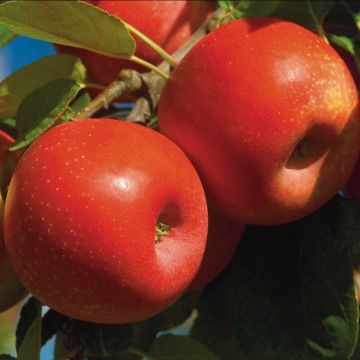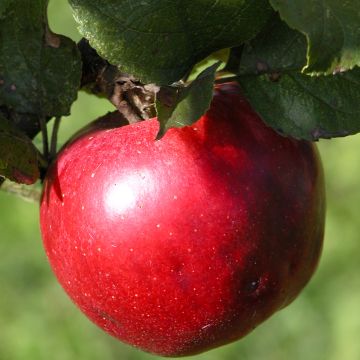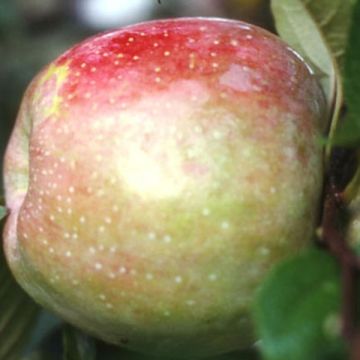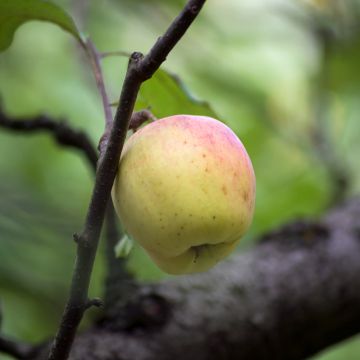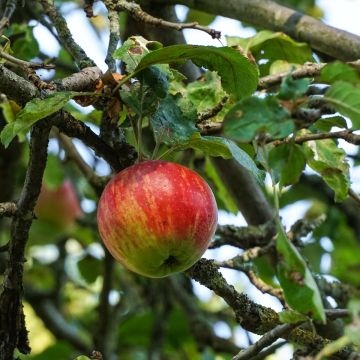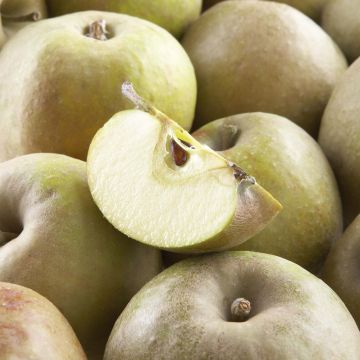

Apple Tree Jonathan - Malus domestica
Apple Tree Jonathan - Malus domestica
Malus domestica Jonathan
Apple, Orchard apple, Table apple, Cultivated apple
This item cannot be shipped to the selected country
Oversize package delivery charge from €6.90
Oversize package delivery charge from €6.90
Oversize package delivery charge from €6.90
More information
Oversize package delivery charge from €6.90
Oversize package delivery charge from €6.90
Oversize package delivery charge from €6.90
More information
Schedule delivery date,
and select date in basket
This plant carries a 6 months recovery warranty
More information
We guarantee the quality of our plants for a full growing cycle, and will replace at our expense any plant that fails to recover under normal climatic and planting conditions.
Oversize package: home delivery by special carrier from €6.90 per order..
Express home delivery from €8.90.
Oversize package: home delivery by special carrier from €6.90 per order..
Express home delivery from €8.90.
Oversize package: home delivery by special carrier from €6.90 per order..
Express home delivery from €8.90.

Description
The 'Jonathan' apple tree is an old variety, with a mid-late flowering time, and a consistent yield, forming a tree with a wide structure. It produces a round apple, of medium size, with a smooth, thin, shiny skin, golden yellow, abundantly striped with bright red, especially on the sunny side, with few lenticels. Its creamy white flesh is firm, crisp, moderately juicy, sweet and tart, with a flavourful taste. Harvest begins around early October, the fruits are consumable from November and can be stored until February if picked late. Pleasantly tart and rich in sugars, it is a delicious apple to enjoy throughout the winter. Excellent cooked, in pies, compotes, or pan-fried, it is also highly appreciated in savory recipes. It is a self-sterile variety that requires the presence of other apple varieties to improve pollination.
The Malus domestica, also known scientifically as Malus communis or Malus pumila, is commonly called the Common or Domestic Apple tree. It belongs to the Rosaceae family. Present in France and Europe since ancient times, it is a fruit tree native to the forests of Central Asia. It has excellent hardiness and is probably the most cultivated fruit tree in Northern Europe. There are about 20,000 varieties, including approximately 10,000 of American origin, 2,000 of English origin, and 2,000 of Chinese origin. The 'Jonathan' Malus domestica is an old variety, resulting from a crossbreeding of 'Esopus Spitzenberg' in the United States at Philippe Rick's farm in Woodstock, New York in 1826. Widely cultivated in America, it is classified among the best apples. Introduced to Europe in 1880, it is quite common in the Hauts-de-France region and Wallonia in Belgium.
The 'Jonathan' Apple tree is a spreading tree, with a wide structure that can reach a diameter of 6 metres (20 feet). Its habit is suitable for both low and tall forms. Its foliage consists of large, ovate leaves, greenish-brown on top, whitish-green underneath, deeply toothed. The mid-late flowering occurs in late April, which generally protects it from frost. The white flowers are destroyed by frost at temperatures below -2 to -3°C (28.4 to 26.6°F). It is a hardy tree that can withstand temperatures around -30°C (-22°F), making it suitable for cultivation in all regions of France. Varieties such as 'Cox's Orange', 'Golden Delicious', 'Granny Smith', 'Idared', 'Reine des Reinettes', 'Transparente de Croncels' or any other mid-late flowering variety are suitable for cross-pollination and obtaining satisfactory fruiting. Ornamental apple trees, such as 'Perpetu Evereste' and 'John Downie' crabapples, bloom abundantly and can be excellent pollinators.
The 'Jonathan' Apple tree is a vigorous variety, with a medium but consistent yield, and a rapid fruiting period, resistant to scab and susceptible to powdery mildew.
The apple can be consumed both raw and cooked, in compotes, pastries, paired with cheeses, or as an accompaniment to savoury dishes, with black pudding, pork, or in salads. It is also perfect for making juice. Rich in carbohydrates and fructose, it is invigorating, energising, and rehydrating. Its content of vitamins A, B, C, and E, minerals, antioxidants, and dietary fibre makes the apple a health asset. The fruits can be stored until February if picked late. Storage can be done in a cool, clean place, protected from light, at a temperature of around 8 to 10°C (46.4 to 50°F) or in a cold room, sealed from outside air, at a temperature of 1 to 3°C (33.8 to 37.4°F). The apple releases ethylene, a gas that promotes fruit ripening. To accelerate the ripening of other fruits or vegetables, place your apples next to them.
Very popular thanks to its fruits, the 'Jonathan' apple tree finds its place in the garden for the enjoyment of young and old. Among a very wide range of apple trees, it is easy to find the variety that best suits one's desires.
Apple Tree Jonathan - Malus domestica in pictures


Plant habit
Fruit
Flowering
Foliage
Botanical data
Malus
domestica
Jonathan
Rosaceae
Apple, Orchard apple, Table apple, Cultivated apple
Cultivar or hybrid
Other Apple trees
Planting and care
Choose a sunny location for your 'Jonathan' Apple tree, the soil can be slightly chalky or acidic, but not excessively. Dig a large planting hole at least 3 times the volume of the root ball. Simultaneously add organic matter (topsoil, compost) and a base fertiliser such as crushed horn. Do not bury the graft collar. Stake if necessary. For apple trees planted in isolation and in open ground, it may be interesting to stake them by installing a bracing system: plant 3 stakes in a triangle 50 cm (20in) around the trunk, connect them together with pieces of wood. Protect the bark with a piece of rubber for example and attach the stakes to the trunk with metal wire. Water abundantly, even in winter, even if it rains. Fruit trees are ideally planted between October and March, outside the freezing period. Container-grown plants can be planted all year round except during periods of high heat or frost.
In winter, at the base of the tree and lightly incorporated into the surface of the soil, you can add a small handful of wood ash, rich in potash, which will improve fruiting. The Apple tree can be subject to different diseases and pests. In order to limit risks, space the trees sufficiently, install multi-species hedges, birdhouses or insect hotels to attract beneficial insects. In summary: prioritise diversity. The main diseases of the Apple tree are apple scab (brown spots on the leaves), brown rot (wilting of the flowers and rotting of the fruits on the tree) and powdery mildew (white powdery coating on the leaves). For these three cases, preventive action should be favored by spraying a decoction of horsetail, as a last resort and in case of severe attacks, you can apply a treatment based on Bordeaux mixture. As for pests, the codling moth (or fruit worm) is a small caterpillar, resulting from the laying of a butterfly larvae, which causes tunnels inside the fruit. To remedy this, it is preferable to act preventively by promoting the installation of tits and bats, by placing nest boxes. In case of aphid attack, spray a solution based on black soap.
During the harvest in September, only keep the picked fruits. For good storage, it is desirable to place the apple with its stem downwards, on racks or in crates. Choose a preferably completely dark, dry and cool place, but frost-free.
Planting period
Intended location
Care
Haven't found what you were looking for?
Hardiness is the lowest winter temperature a plant can endure without suffering serious damage or even dying. However, hardiness is affected by location (a sheltered area, such as a patio), protection (winter cover) and soil type (hardiness is improved by well-drained soil).

Photo Sharing Terms & Conditions
In order to encourage gardeners to interact and share their experiences, Promesse de fleurs offers various media enabling content to be uploaded onto its Site - in particular via the ‘Photo sharing’ module.
The User agrees to refrain from:
- Posting any content that is illegal, prejudicial, insulting, racist, inciteful to hatred, revisionist, contrary to public decency, that infringes on privacy or on the privacy rights of third parties, in particular the publicity rights of persons and goods, intellectual property rights, or the right to privacy.
- Submitting content on behalf of a third party;
- Impersonate the identity of a third party and/or publish any personal information about a third party;
In general, the User undertakes to refrain from any unethical behaviour.
All Content (in particular text, comments, files, images, photos, videos, creative works, etc.), which may be subject to property or intellectual property rights, image or other private rights, shall remain the property of the User, subject to the limited rights granted by the terms of the licence granted by Promesse de fleurs as stated below. Users are at liberty to publish or not to publish such Content on the Site, notably via the ‘Photo Sharing’ facility, and accept that this Content shall be made public and freely accessible, notably on the Internet.
Users further acknowledge, undertake to have ,and guarantee that they hold all necessary rights and permissions to publish such material on the Site, in particular with regard to the legislation in force pertaining to any privacy, property, intellectual property, image, or contractual rights, or rights of any other nature. By publishing such Content on the Site, Users acknowledge accepting full liability as publishers of the Content within the meaning of the law, and grant Promesse de fleurs, free of charge, an inclusive, worldwide licence for the said Content for the entire duration of its publication, including all reproduction, representation, up/downloading, displaying, performing, transmission, and storage rights.
Users also grant permission for their name to be linked to the Content and accept that this link may not always be made available.
By engaging in posting material, Users consent to their Content becoming automatically accessible on the Internet, in particular on other sites and/or blogs and/or web pages of the Promesse de fleurs site, including in particular social pages and the Promesse de fleurs catalogue.
Users may secure the removal of entrusted content free of charge by issuing a simple request via our contact form.

































